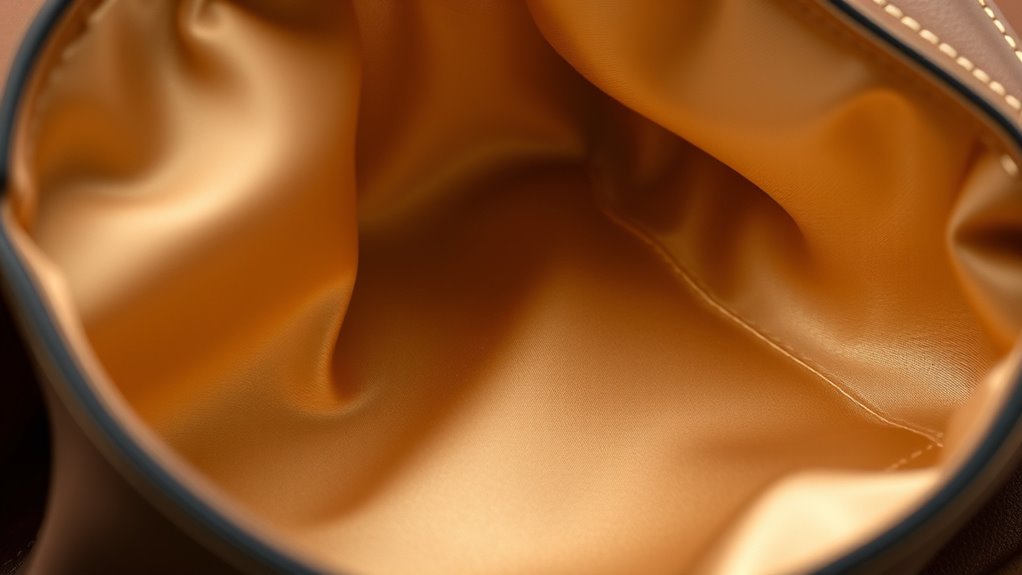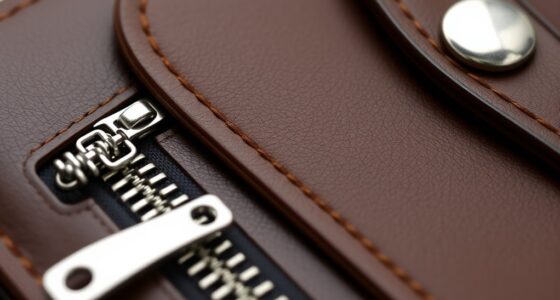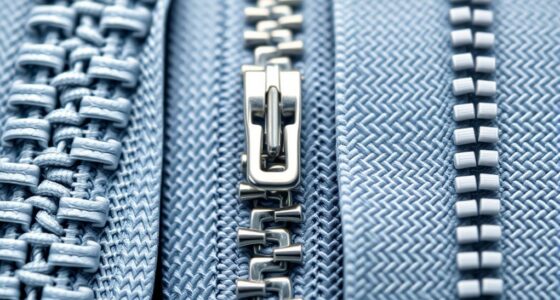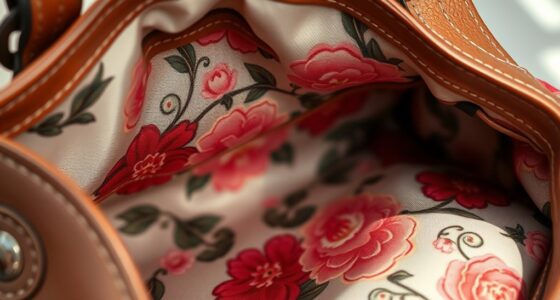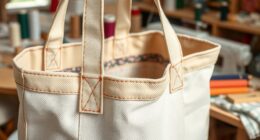The lining of a quality bag is vital because it keeps the shape, offers organization, and enhances durability. It supports the bag’s structure, prevents items from shifting, and protects against water and wear. High-quality linings are carefully stitched, reinforced, and made from durable, water-resistant fabrics. These hidden construction details make a big difference in a bag’s longevity and style. Keep exploring to uncover more secrets behind the craftsmanship of top-tier bags.
Key Takeaways
- Quality lining provides structural support, helping bags maintain shape and resist sagging over time.
- Durable linings ensure longevity by resisting wear, tearing, and fraying, especially in high-stress areas.
- Well-constructed linings enhance interior organization with compartments and pockets, improving functionality.
- Water-resistant linings protect contents from spills and rain, extending the bag’s lifespan.
- Precise stitching and reinforcement techniques secure seams, preventing tearing and ensuring long-term durability.
The Structural Role of Bag Linings in Maintaining Shape
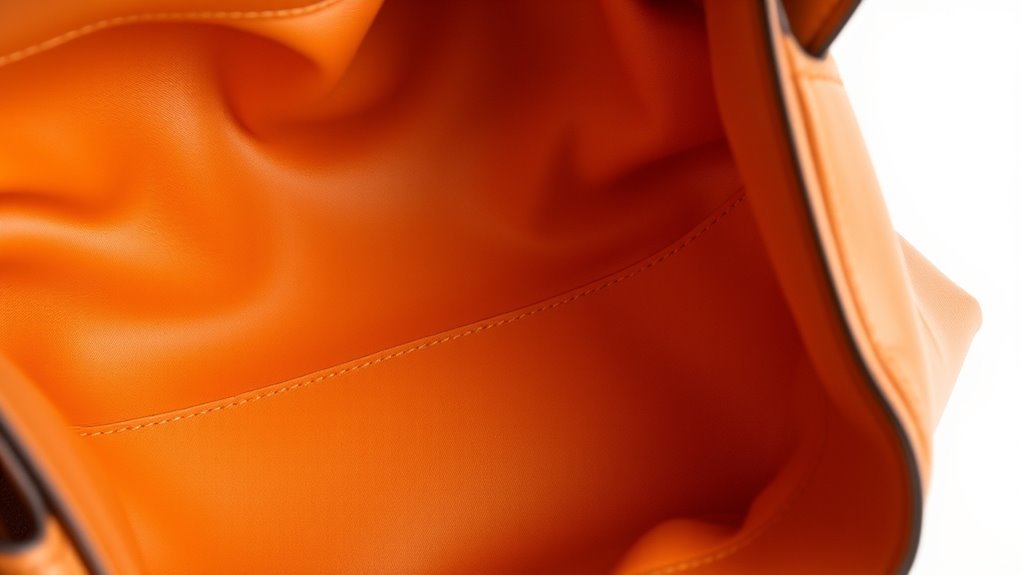
Bag linings play an essential role in giving bags their shape and structure. The right lining materials provide support that helps maintain the bag’s form, even when filled with items. When you choose high-quality linings, you’ll notice that your bag retains its shape longer, preventing sagging or collapsing. These materials are designed to add stiffness and stability, ensuring the bag looks polished and stays functional over time. Lightweight yet supportive linings, like certain fabrics or coated materials, contribute markedly to shape retention without adding unnecessary bulk. Additionally, material selection directly impacts the durability and flexibility of the bag, ensuring it withstands daily use. By selecting the proper lining, you’re investing in a bag that holds its structure, making it easier to organize your belongings and keep the bag looking new for longer.
Materials That Make or Break Bag Durability
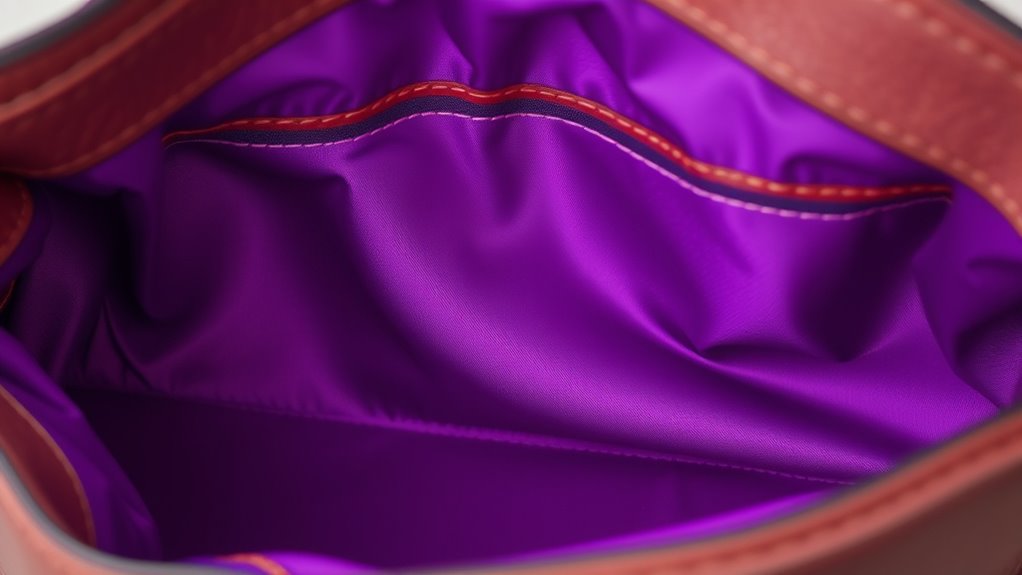
The durability of a bag largely depends on the materials used in its construction, as some materials withstand daily wear and tear better than others. For example, high-quality leather and sturdy synthetic fabrics can last years, even with frequent use. Fashion trends influence material choices, but durability remains essential regardless of style. Eco-friendly materials, like recycled fabrics and plant-based leathers, are gaining popularity because they offer sustainability without sacrificing strength. Cheaper materials may look good initially but tend to break down quickly, leading to tears and fraying. When selecting a bag, prioritize durable fabrics that align with current fashion trends and eco-conscious values. This ensures your bag not only stays in style but also lasts longer, saving you money and reducing environmental impact. Additionally, understanding the importance of materials in hackathons can inspire innovative designs that emphasize sustainability and longevity.
The Impact of Lining on Interior Organization and Accessibility
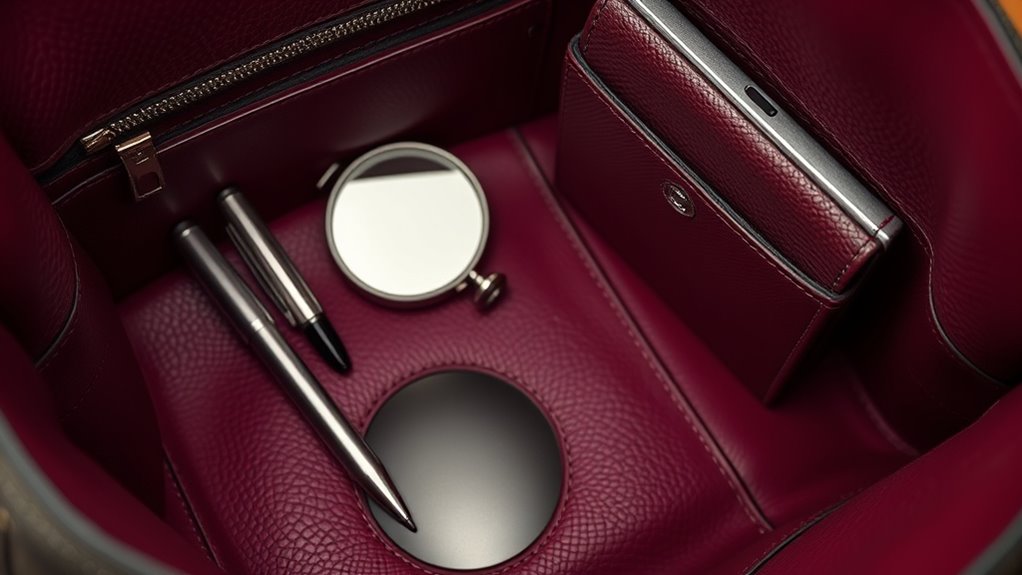
A well-chosen lining can markedly enhance a bag’s interior organization and ease of access. Quality linings often include multiple interior compartments that help you sort your essentials efficiently, reducing clutter and making items easier to find. Accessibility features like dedicated pockets, zippered sections, and slip-in sleeves ensure quick retrieval of frequently used items. The right lining material also prevents items from slipping or shifting, maintaining order inside your bag. When designed thoughtfully, the lining allows you to access your belongings smoothly without rummaging through layers. This improves overall functionality, especially when you’re on the go. Additionally, a well-constructed lining supports interior organization, helping you keep everything in its place. In short, a carefully selected lining transforms a bag into a highly organized, user-friendly space, making your daily routine more streamlined.
How Lining Enhances Water Resistance and Protection
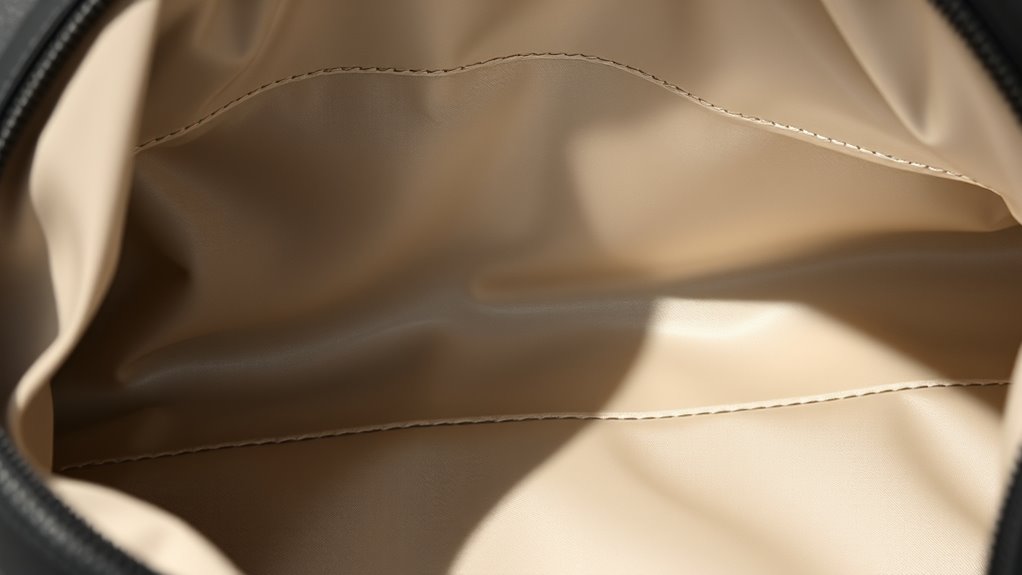
When your bag encounters rain or spills, a lining designed for water resistance acts as a crucial barrier, preventing moisture from seeping into your belongings. Fabric textures like smooth nylon or coated polyester are essential, as they repel water effectively. These materials help keep your items dry and protected, even in unexpected weather. The lining colors also play a role; darker shades hide stains and water spots better, maintaining a clean appearance over time. A water-resistant lining not only shields your belongings but also extends your bag’s durability. By choosing linings crafted with specific fabric textures and appropriate colors, you ensure your bag provides reliable protection against moisture, keeping your essentials safe no matter the conditions. Additionally, selecting durable materials that withstand wear and tear helps maintain the bag’s integrity over time.
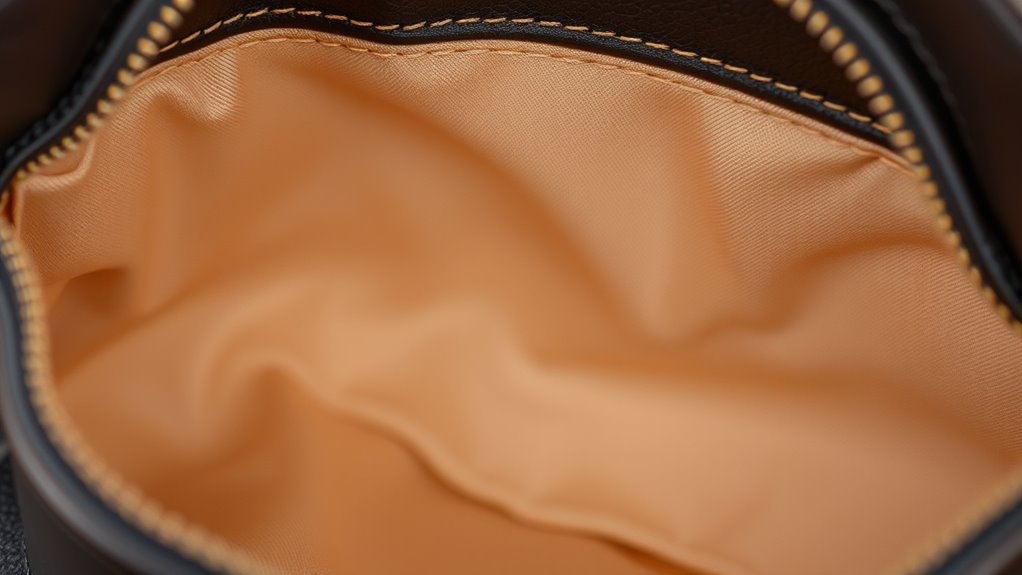
You might not notice, but the way your bag is stitched guarantees a lot for its lifespan. Reinforced stitch patterns and strong lining materials prevent tearing and wear over time. Paying attention to these hidden techniques ensures your bag stays durable and reliable. Additionally, selecting high-quality materials and craftsmanship can significantly extend the longevity of your accessories, emphasizing the importance of construction techniques in bag design.
Reinforced Stitch Patterns
Reinforced stitch patterns are essential hidden techniques that substantially boost the durability of quality bags. By carefully selecting a fabric density that withstands stress, manufacturers ensure the bag’s strength from the inside out. Reinforced stitches, such as bar tacking or box stitches, prevent seams from unraveling over time, especially in high-stress areas like handles and corners. The lining color often complements these stitch patterns, making the reinforcement less visible yet highly effective. Precise stitching ensures that the fabric layers stay securely joined, reducing the risk of tears. These reinforced stitch patterns provide a layer of resilience, allowing your bag to handle daily wear and tear while maintaining its shape and structure for years to come. Additionally, understanding for sale 100 can help inform choices about quality and value when selecting durable bags.
Durable Lining Materials
Choosing the right lining materials is essential for ensuring your bag’s longevity, especially when combined with hidden stitching and reinforcement techniques. Durable linings like nylon, polyester, or canvas resist wear and tear, keeping your bag looking new longer. Fabric patterns and lining colors also matter—they can hide stains or scratches better than plain fabrics. Selecting sturdy materials prevents tearing and extends your bag’s life. Reinforced edges and hidden stitches work best with tough linings, making sure seams stay intact over time. Here’s a quick comparison to help you choose:
| Fabric Pattern | Lining Colors |
|---|---|
| Solid | Dark or neutral |
| Printed | Bright or patterned |
| Textured | Muted shades |
| Plain | Vibrant colors |
| Quilted | Subtle hues |
Opt for materials that match your needs for durability and style. Additionally, understanding reinforcement techniques helps in designing longer-lasting bags.
The Aesthetic Influence of Lining Choices on Overall Design
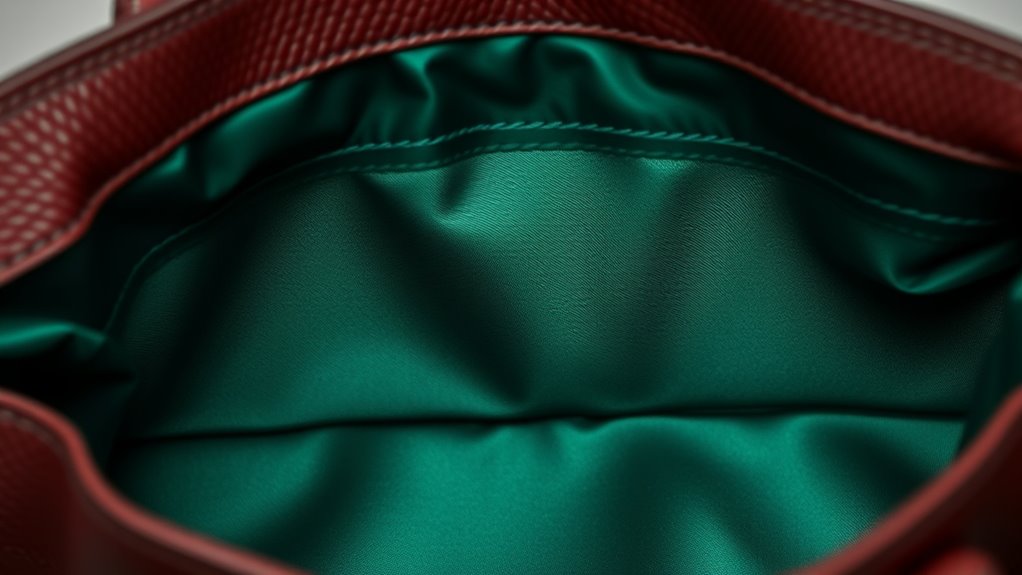
The lining choices in quality bags substantially influence their overall aesthetic appeal, often serving as the subtle finishing touch that elevates the design. Your selection of lining color or pattern can create striking color contrast or seamless pattern coordination, enhancing the bag’s visual harmony. When you choose a bold lining, it adds a pop of surprise inside a classic exterior. Conversely, matching patterns or subtle hues keep the look refined and cohesive. The right lining can also complement hardware or exterior details, tying the entire design together. Whether you prefer a sleek, monochrome interior or an eye-catching print, your lining choice impacts the bag’s style statement. It’s the detail that transforms a simple bag into a thoughtfully designed accessory.
Insider Tips for Recognizing Quality Lining in Handcrafted Bags
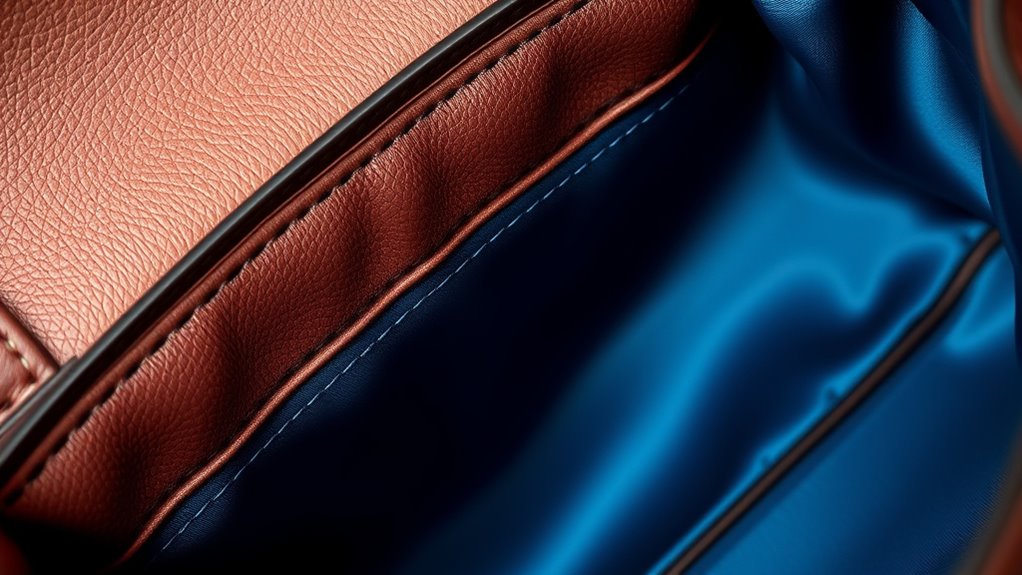
To recognize quality lining in handcrafted bags, focus on how smoothly the interior fabric moves and whether it feels durable under your fingers. Well-made linings often feature neat, consistent lining patterns that resist puckering or wrinkling. Look for linings with tight, even stitching along the seams—this indicates careful craftsmanship. Pay attention to lining color options; high-quality bags often use lining colors that complement or subtly contrast the exterior, showing thoughtful design. Avoid linings that feel flimsy or overly stiff, as these can wear quickly. A quality lining should feel substantial yet flexible, providing protection without sacrificing comfort. Additionally, inspecting the lining’s material can reveal its material composition, which impacts durability and feel. By inspecting these details, you can better determine if a bag’s lining is built to last and crafted with attention to detail.
Frequently Asked Questions
How Does Lining Affect a Bag’s Overall Weight and Comfort?
Lining markedly impacts your bag’s overall weight and comfort. Thicker lining materials add weight, making the bag feel heavier to carry, while thinner linings keep it light and more comfortable. The choice of lining thickness influences how you feel when holding or wearing the bag. Opt for quality bag materials with balanced lining thickness to guarantee durability without sacrificing comfort, making your experience more enjoyable and practical.
Are Synthetic Linings as Durable as Natural Fabrics?
Synthetic linings often match natural fabrics in durability, but they typically lack fabric breathability, which can affect your comfort. While synthetics tend to have a lower environmental impact during production, they may not biodegrade as easily. If you prioritize durability and eco-friendliness, natural fabrics might be better, but for moisture resistance and longevity, synthetics can be a solid choice. Consider your needs to choose the best lining for your bag.
What Signs Indicate a Poorly Constructed Lining?
You notice a poorly constructed lining through uneven stitching or loose threads, which reveal its lack of durability. Unlike a well-installed lining, signs of poor lining installation include puckering, gaps, or fraying edges. These issues highlight that the lining can’t withstand daily use, compromising your bag’s longevity. If these signs appear, it’s clear that the lining wasn’t crafted with proper attention to lining durability and installation.
Can Lining Choice Influence a Bag’s Resale Value?
Your choice of lining material can profoundly influence a bag’s resale value. High-quality linings suggest durability and attention to detail, making the bag more desirable to buyers. Conversely, cheap or poorly chosen lining materials may signal lower craftsmanship, reducing its resale appeal. When selecting a bag, consider how the lining material enhances longevity and aesthetics, as these factors can boost its value when you decide to sell later.
How Do Different Lining Colors Impact Style Versatility?
Different lining colors greatly impact your bag’s style versatility. Neutral tones like black, beige, or gray easily coordinate with various outfits, enhancing seasonal adaptability. Bright or bold linings add a pop of personality but might limit pairing options. By choosing versatile lining colors, you guarantee your bag complements multiple styles and seasons, making it a practical, fashionable accessory. This smart choice boosts your bag’s overall appeal and usability.
Conclusion
Remember, the devil is in the details, and choosing the right lining can make or break your bag’s longevity and style. By paying attention to materials, craftsmanship, and design, you ensure your bag stays beautiful and functional for years. Don’t overlook the hidden layers—they’re the secret to quality. As the saying goes, “A well-laid foundation is the key to a lasting structure,” so invest wisely in your bag’s lining for lasting satisfaction.
